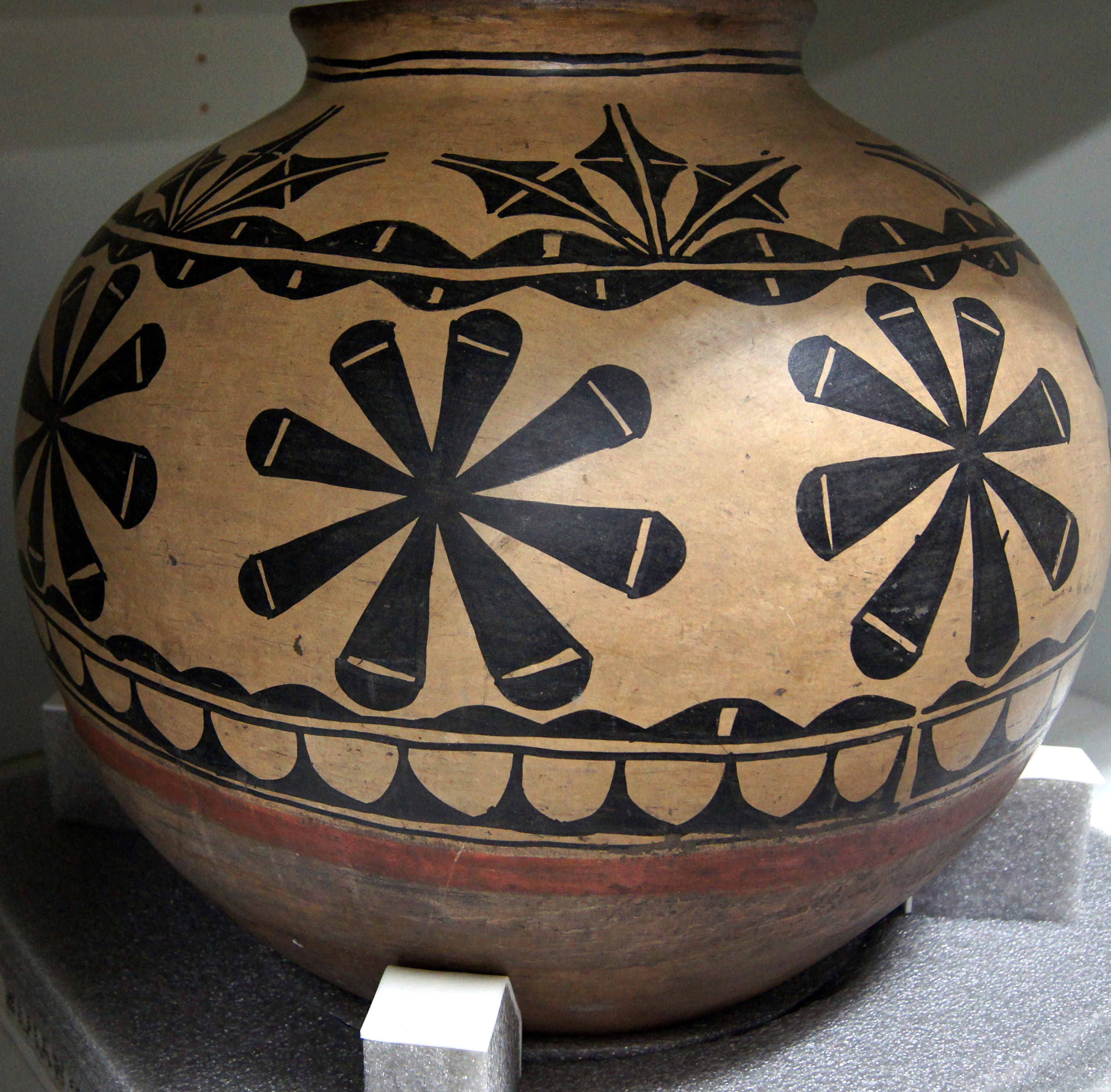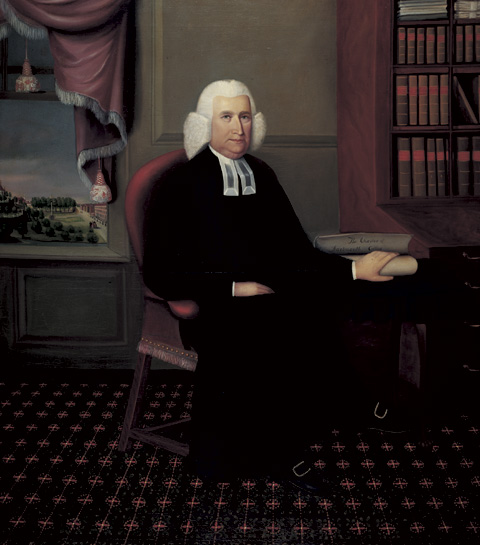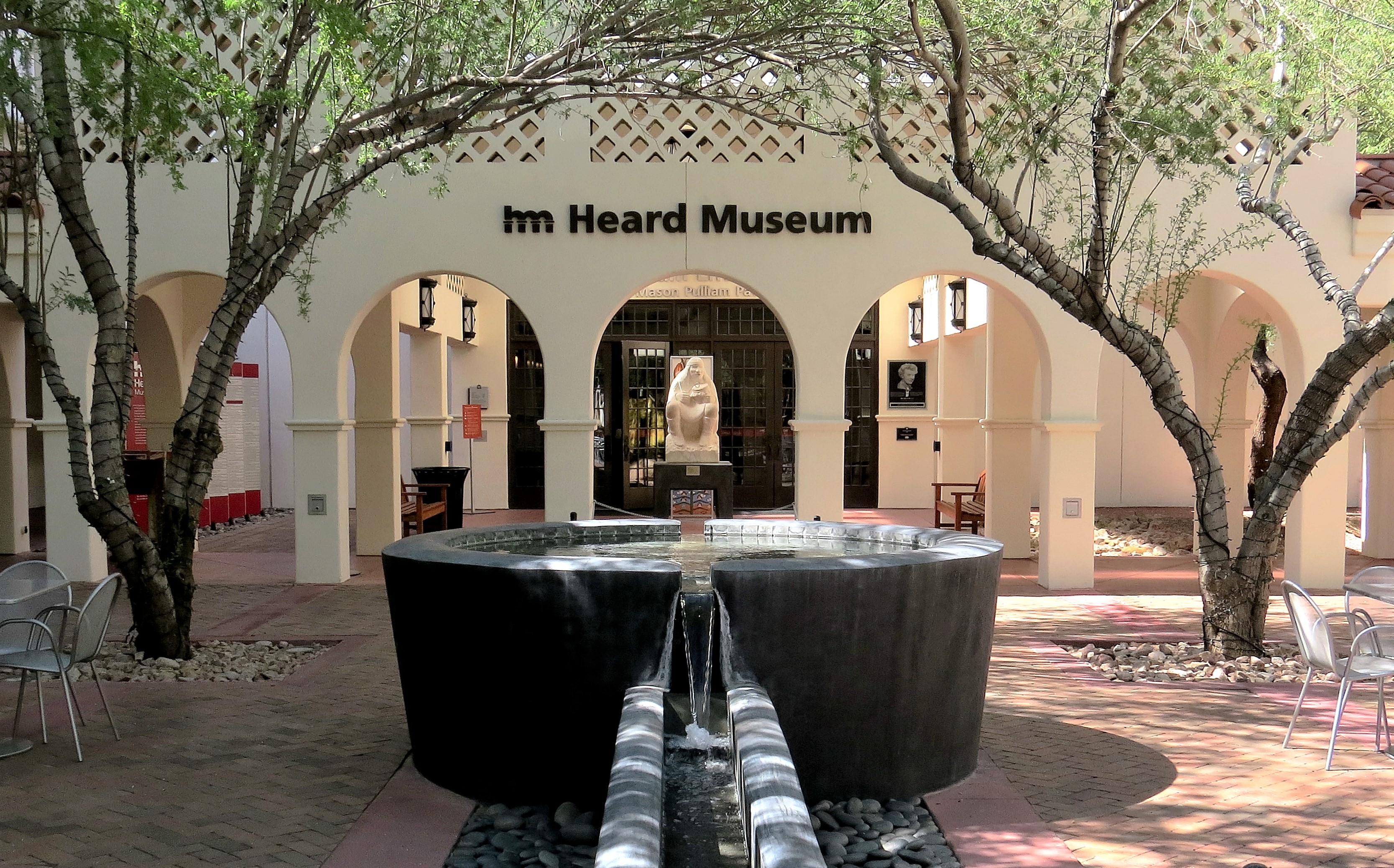|
Tonita Peña
Tonita Peña (born May 10, 1893 in San Ildefonso – died September 9, 1949 in Santo Domingo Pueblo) born as Quah Ah (meaning white coral beads) but also used the name Tonita Vigil Peña and María Antonia Tonita Peña. Peña was a renowned Pueblo artist, specializing in pen and ink on paper embellished with watercolor. She was a well-known and influential Native American artist and art teacher of the early 1920s and 1930s. Early life and education Tonita Peña was the daughter of Ascensión Vigil Peña and Natividad Peña of San Ildefonso Pueblo, New Mexico but at age 12, her mother and younger sister died, as a results of complications due to the flu. Her father was unable to care for her and she was taken to Cochití Pueblo and was brought up by her aunt, Martina Vigil Montoya, a prominent Cochití Pueblo potter. Peña attended St. Catherine Indian School in Santa Fe. Career and later life Edgar Lee Hewett, an anthropologist involved in supervising the nearby Frijoles Ca ... [...More Info...] [...Related Items...] OR: [Wikipedia] [Google] [Baidu] |
Cochiti, New Mexico
Cochiti (; Eastern Keresan: Kotyit ʰocʰi̥tʰ– "Forgotten", Navajo: ''Tǫ́ʼgaaʼ'') is a census-designated place (CDP) in Sandoval County, New Mexico, United States. A historic pueblo of the Cochiti people, it is part of the Albuquerque Metropolitan Statistical Area. The population was 528 at the 2010 census. Located 22 miles (35 km) southwest of Santa Fe, the community is listed as a historic district on the National Register of Historic Places. Geography According to the United States Census Bureau, the CDP has a total area of , all land. Demographics At the 2010 census, there were 528 people, 157 households and 127 ''families'' residing in the CDP. The population density was 440 per square mile (169.9/km). There were 178 housing units at an average density of 149.9 per square mile (59.1/km). The racial makeup of the CDP was 95.1% Native American, 1.5% White, 1.3% from other races, and 2.1% from two or more races. Hispanic or Latino of any race were 6.6% of the p ... [...More Info...] [...Related Items...] OR: [Wikipedia] [Google] [Baidu] |
Oqwa Pi
Oqwa Pi (English: Red Cloud or Kachina Stick) also known as Abel Sanchez (1899–1971), was a San Ildefonso Pueblo painter, muralist, and politician. Pi was known for his brightly colored paintings. He served as governor of the San Ildefonso Pueblo for six terms. Biography Oqwa Pi was born in 1899 in San Ildefonso Pueblo (Tewa: ''P'ohwhóge Owingeh'') in New Mexico. He was educated at the Santa Fe Indian School, where he learned watercolor and mural paintings; he studied with Dorothy Dunn. The Indian School later commissioned him to create murals at the school. He then returned to the pueblo where he married and had a number of children. In 1931, the Exhibition of Indian Tribal Arts at the Grand Central Galleries in New York City happened, and as a result, Pi's work toured and was shown nationally including at the Museum of Modern Art. He attended the Santa Fe Indian School, studying under Dorothy Dunn. Pi has a mural at the Santa Fe Indian School, in the dining room. Oqwa Pi ... [...More Info...] [...Related Items...] OR: [Wikipedia] [Google] [Baidu] |
Peabody Museum Of Archaeology And Ethnology
The Peabody Museum of Archaeology and Ethnology is a museum affiliated with Harvard University in Cambridge, Massachusetts. Founded in 1866, the Peabody Museum is one of the oldest and largest museums focusing on anthropological material, with particular focus on the ethnography and archaeology of the Americas. The museum is caretaker to over 1.2 million objects, some of documents, 2,000 maps and site plans, and approximately 500,000 photographs. The museum is located at Divinity Avenue on the Harvard University campus. The museum is one of the four Harvard Museums of Science and Culture open to the public. History The museum was established through an October 8, 1866 gift from wealthy American financier and philanthropist George Peabody, a native of South Danvers (now eponymously named Peabody, Massachusetts). Peabody committed $150,000 to be used, according to the terms of the trust, to establish the position of Peabody Professor-Curator, to purchase artifacts, and to constr ... [...More Info...] [...Related Items...] OR: [Wikipedia] [Google] [Baidu] |
Brown University
Brown University is a private research university in Providence, Rhode Island. Brown is the seventh-oldest institution of higher education in the United States, founded in 1764 as the College in the English Colony of Rhode Island and Providence Plantations. Brown is one of nine colonial colleges chartered before the American Revolution. Admissions at Brown is among the most selective in the United States. In 2022, the university reported a first year acceptance rate of 5%. It is a member of the Ivy League. Brown was the first college in the United States to codify in its charter that admission and instruction of students was to be equal regardless of their religious affiliation. The university is home to the oldest applied mathematics program in the United States, the oldest engineering program in the Ivy League, and the third-oldest medical program in New England. The university was one of the early doctoral-granting U.S. institutions in the late 19th century, adding masters ... [...More Info...] [...Related Items...] OR: [Wikipedia] [Google] [Baidu] |
Haffenreffer Museum Of Anthropology
The Haffenreffer Museum of Anthropology is Brown University's teaching and research museum. The museum has a gallery in Manning Hall on Brown's campus in Providence, Rhode Island. Its Collections Research Center is located in nearby Bristol, Rhode Island. Background History The Haffenreffer Museum's origins lie in the private collection of industrialist Rudolf F. Haffenreffer. In 1917, Haffenreffer acquired the Mount Hope Grant, a Bristol estate which encompassed the home of Wampanoag sachem Metacomet. Haffenreffer discovered a number of artifacts on the property and acquired others during trips through the Western United States. In 1928, he constructed the Haffenreffer Museum of the American Indian to house his collection. Following his death in 1954, Haffenreffer's family donated his collection and estate to Brown University. Under the tenure of founding director J. Louis Giddings, the museum's scope expanded to include artifacts from the Arctic, Africa, and Pacific. In ... [...More Info...] [...Related Items...] OR: [Wikipedia] [Google] [Baidu] |
Dartmouth College
Dartmouth College (; ) is a private research university in Hanover, New Hampshire. Established in 1769 by Eleazar Wheelock, it is one of the nine colonial colleges chartered before the American Revolution. Although founded to educate Native Americans in Christian theology and the English way of life, the university primarily trained Congregationalist ministers during its early history before it gradually secularized, emerging at the turn of the 20th century from relative obscurity into national prominence. It is a member of the Ivy League. Following a liberal arts curriculum, Dartmouth provides undergraduate instruction in 40 academic departments and interdisciplinary programs, including 60 majors in the humanities, social sciences, natural sciences, and engineering, and enables students to design specialized concentrations or engage in dual degree programs. In addition to the undergraduate faculty of arts and sciences, Dartmouth has four professional and graduate schools: ... [...More Info...] [...Related Items...] OR: [Wikipedia] [Google] [Baidu] |
Heard Museum
The Heard Museum is a private, not-for-profit museum in Phoenix, Arizona, United States, dedicated to the advancement of American Indian art. It presents the stories of American Indian people from a first-person perspective, as well as exhibitions of traditional and contemporary art by American Indian artists and artists influenced by American Indian art. The Heard Museum collaborates with American Indian artists and tribal communities on providing visitors with a distinctive perspective about the art of Native people, especially those from the Southwest. The Heard Museum's mission is to be "the world's preeminent museum for the presentation, interpretation and advancement of American Indian art, emphasizing its intersection with broader artistic and cultural themes." The main Phoenix location of the Heard Museum has been designated as a Phoenix Point of Pride. The museum operated the Heard Museum West branch in Surprise which closed in 2009. The museum also operated the Heard ... [...More Info...] [...Related Items...] OR: [Wikipedia] [Google] [Baidu] |
Cranbrook Schools
Cranbrook Schools is a private, PK–12 preparatory school located on a campus in Bloomfield Hills, Michigan. The schools comprise a co-educational elementary school, a middle school with separate schools for boys and girls, and a co-educational high school with boarding facilities. Cranbrook Schools is part of the Cranbrook Educational Community (CEC), which includes the Cranbrook Institute of Science, the Cranbrook Academy of Art, and Cranbrook House and Gardens. (Nearby Christ Church Cranbrook remains outside this formal structure.) The Cranbrook community was established by publishing mogul George Booth, who bought the site of today's Cranbrook community in 1904. Cranbrook was designated a National Historic Landmark on June 29, 1989 for its significant architecture and design. It attracts tourists from around the world. Approximately of Cranbrook Schools' campus are gardens. As of 2015, Cranbrook Schools had an endowment of $233 million, among the fifteen largest held by ... [...More Info...] [...Related Items...] OR: [Wikipedia] [Google] [Baidu] |
Cleveland Museum Of Art
The Cleveland Museum of Art (CMA) is an art museum in Cleveland, Ohio, located in the Wade Park District, in the University Circle neighborhood on the city's east side. Internationally renowned for its substantial holdings of Asian and Egyptian art, the museum houses a diverse permanent collection of more than 61,000 works of art from around the world. The museum provides general admission free to the public. With a $755 million endowment, it is the fourth-wealthiest art museum in the United States. With about 770,000 visitors annually (2018), it is one of the most visited art museums in the world. History Beginnings The Cleveland Museum of Art was founded as a trust in 1913 with an endowment from prominent Cleveland industrialists Hinman Hurlbut, John Huntington, and Horace Kelley. The neoclassical, white Georgian Marble, Beaux-Arts building was constructed on the southern edge of Wade Park, at the cost of $1.25 million. Wade Park and the museum were designed by the loca ... [...More Info...] [...Related Items...] OR: [Wikipedia] [Google] [Baidu] |
American Museum Of Natural History
The American Museum of Natural History (abbreviated as AMNH) is a natural history museum on the Upper West Side of Manhattan in New York City. In Theodore Roosevelt Park, across the street from Central Park, the museum complex comprises 26 interconnected buildings housing 45 permanent exhibition halls, in addition to a planetarium and a library. The museum collections contain over 34 million specimens of plants, animals, fossils, minerals, rocks, meteorites, human remains, and human cultural artifacts, as well as specialized collections for frozen tissue and genomic and astrophysical data, of which only a small fraction can be displayed at any given time. The museum occupies more than . AMNH has a full-time scientific staff of 225, sponsors over 120 special field expeditions each year, and averages about five million visits annually. The AMNH is a private 501(c)(3) organization. Its mission statement is: "To discover, interpret, and disseminate—through scientific research and ... [...More Info...] [...Related Items...] OR: [Wikipedia] [Google] [Baidu] |
Joe Herrera
Joe Hilario Herrera (also known as See-Ru; born 1923–2001), was an American Pueblo painter, teacher, radio newscaster, politician, and a Pueblo activist; from a mixed Cochiti and San Ildefonso background. He was the son of the artist Tonita Peña, and had trained at the Santa Fe Indian School. Early life and education Joe Hilario Herrera was born on May 17, 1923, in Cochiti, New Mexico. His father Felipe Herrera, was from Cochiti, where he grew up. While his mother, Tonita Peña was from San Ildefonso. Herrera inherited rich artistic traditions from both of his parents. His early interest in painting was stimulated by watching his mother's husband, Julian Martinez paint, but above all through the strong influence of his mother, who was the most prominent Native American female painter of her generation. Herrera swatted flies away from his mother's paint dishes while she worked, and in return she gave him paint with which he began to experiment at the age of five. Like many ... [...More Info...] [...Related Items...] OR: [Wikipedia] [Google] [Baidu] |
National Museum Of The American Indian George Gustav Heye Center
The National Museum of the American Indian–New York, the George Gustav Heye Center, is a branch of the National Museum of the American Indian at the Alexander Hamilton U.S. Custom House in Manhattan, New York City. The museum is part of the Smithsonian Institution. The center features contemporary and historical exhibits of art and artifacts by and about Native Americans. The center has its origin in the ''Museum of the American Indian'' founded by George Heye in 1916. It became part of the national museum and Smithsonian in 1987. History The center is named for George Gustav Heye, who began collecting Native American artifacts in 1903. He founded and endowed the Museum of the American Indian in 1916, and it opened in 1922, in a building at 155th Street and Broadway, part of the Audubon Terrace complex, in the Sugar Hill neighborhood, just south of Washington Heights. By early 1987, U.S. senator Daniel Patrick Moynihan was proposing legislation that would turn over the Alex ... [...More Info...] [...Related Items...] OR: [Wikipedia] [Google] [Baidu] |
%2C_San_Ildefonso_and_Cochita%2C_New_Mexico_PM_2008.20.46.jpg)









